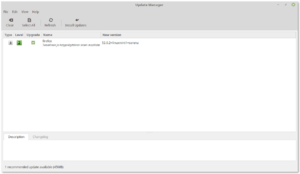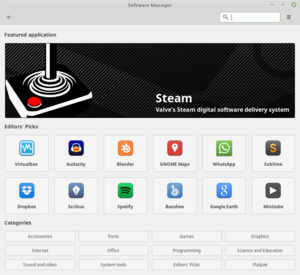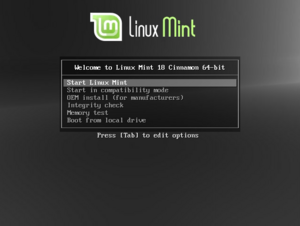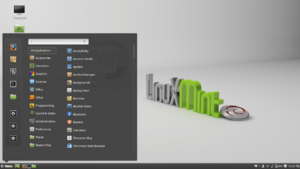Linux Mint facts for kids
 |
|
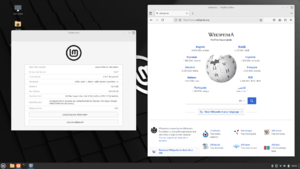
Linux Mint 22 "Wilma" using Cinnamon 6.2.7
|
|
| Company / developer | Clément Lefèbvre, Linux Mint Teams and community |
|---|---|
| OS family | Linux (Unix-like) |
| Working state | Current |
| Source model | Open source |
| Initial release | 27 August 2006 |
| Latest stable release | |
| Available language(s) | Multilingual |
| Package manager |
|
| Supported platforms | x86-64 and x86 |
| Kernel type | Monolithic (Linux) |
| Userland | GNU |
| Default user interface | |
| License | Mainly GPL and other free software licenses, minor additions of proprietary software |
Linux Mint is an Ubuntu and Debian-based Linux distribution, it comes bundled with a variety of free and open-source applications. Linux Mint offers three different desktop environments by default; Cinnamon, Xfce, and MATE.
The Linux Mint project was created by Clément Lefèbvre and is actively maintained by the Linux Mint Team and community.
Contents
History
2006-2015
Linux Mint began in 2006 with a beta release, 1.0, code-named 'Ada', based on Kubuntu and using its KDE interface. Linux Mint 2.0 'Barbara' was the first version to use Ubuntu as its codebase and its GNOME interface. It had few users until the release of Linux Mint 3.0, 'Cassandra'.
Linux Mint 2.0 was based on Ubuntu 6.10, using Ubuntu's package repositories and using it as a codebase. It then followed its own codebase, building each release from the previous one, but continuing to use the package repositories of the latest Ubuntu release. This made the two systems' bases almost identical, guaranteeing full compatibility between them, rather than requiring Mint to be a fork.
In 2008, Linux Mint adopted the same release cycle as Ubuntu and dropped its minor version number before releasing version 5 'Elyssa'. The same year, in an effort to increase compatibility between the two systems, Linux Mint decided to abandon its codebase and changed the way it built its releases. Starting with Linux Mint 6 'Felicia', each release was based completely on the latest Ubuntu release, built directly from it, and made available approximately one month after the corresponding Ubuntu release (usually in May or November).
In 2010, Linux Mint released Linux Mint Debian Edition (LMDE). Unlike the other Ubuntu-based editions (Ubuntu Mint), LMDE was originally a rolling release based directly on Debian and not tied to Ubuntu packages or its release schedule. It was announced on May 27, 2015, that the Linux Mint team would no longer support the original rolling release version of LMDE after January 1, 2016. LMDE 2 'Betsy' was a long-term support release based on Debian Jessie. When LMDE 2 was released, it was announced that all LMDE users would be automatically upgraded to new versions of MintTools software and new desktop environments before they were released into the main edition of Linux Mint.
2016-present
On February 20, 2016, the Linux Mint website was breached by unknown hackers who briefly replaced download links for a version of Linux Mint with a modified version containing malware. The hackers also breached the database of the website's user forum. Linux Mint immediately took its server offline and implemented enhanced security configurations for their website and forum.
Starting with Linux Mint 20 only the amd64 (64 bit) architecture will be supported. This is because Canonical decided to drop 32-bit support from Ubuntu 20.04, which is the base from which Linux Mint 20 is derived. LMDE still supports both the x86 i386 (32-bit) and amd64 (64-bit) architectures.
Releases
Every version of Linux Mint is given a version number and code-named with a feminine first name ending in 'a' and beginning with a letter of the alphabet that increased with every major revision. Version 18 broke from the pattern with the name 'Sarah', though in English it retains the same final vowel sound as all of the other releases.
Initially, there were two Linux Mint releases per year. Following the release of Linux Mint 5 in 2008, every fourth release was labeled a long-term support (LTS) version, indicating that it was supported (with updates) for longer than traditional releases. Versions 5 and 9 had three years of support, and all LTS versions following received five years of support.
On May 31, 2014, with the release of Linux Mint 17, the Linux Mint team adopted a new release strategy. Starting with the release of Mint 17, all future versions were planned to use an LTS version of Ubuntu as a base, until 2016. Under this strategy, Mint 17.1 was released on November 29, 2014, Mint 17.2 was released on June 30, 2015, and Mint 17.3 was released on December 4, 2015. The 17.x releases are intended to be an easy, optional upgrade. All three versions included upgrades to the Cinnamon and MATE Desktop Environments and various Mint tools. In addition, Mint 17.2 and 17.3 included an upgrade to the LibreOffice suite. The 18.x series follows the pattern set by the 17.x series, by using Ubuntu 16.04 LTS as a base.
Linux Mint does not communicate specific release dates as new versions are published 'when ready', meaning that they can be released early when the distribution is ahead of schedule or late when critical bugs are found. New releases are announced, with much other material, on the Linux Mint blog.
On January 3, 2018, the Linux Mint Team released news of Linux Mint 19 'Tara'. The team stated that the 19.x releases would use GTK 3.22 and be based on Ubuntu 18.04 LTS, with support provided until 2023. On June 29, 2018, Linux Mint 19 'Tara' Cinnamon was released. Then, on December 24, 2019, Linux Mint 19.3, 'Tricia' was released, with security updates available until 2023.
On June 27, 2020, Linux Mint 20 'Ulyana' was released. It is an LTS version with support until 2025. On January 8, 2021, Linux Mint 20.1 'Ulyssa' was released. On July 8, 2021, Linux Mint 20.2 'Uma' was released. On January 5, 2022, Linux Mint 20.3 "Una" was released.
Up to 2014 there had been two Linux Mint releases per year, about one month after the Ubuntu releases they were based on. Each release was given a new version number and a code name, using a female first name starting with the letter whose alphabetical index corresponds to the version number and ending with the letter "a" (e.g., "Elyssa" for version 5, "Felicia" for version 6). There is also an OEM version for ease of installation for hardware manufacturers.
Releases were timed to be approximately one month after Ubuntu releases (which in turn are about one month after GNOME releases and two months after X Window System releases). Consequently, every Linux Mint release came with an updated version of both GNOME and X and features some of the improvements brought in by the latest Ubuntu release. Support for most releases was discontinued two months after the next release, but since mid-2008 v5, every fourth release has been labelled a long-term support version, indicating that it is supported (with updates) for longer, three years for v5 and v9, and five years thereafter.
Linux Mint 17 "Qiana" LTS was released on May 31, 2014, remaining current until the end of November 2014 and supported until April 2019. In mid-2014 the, successor to 17 Qiana was announced to be 17.1 Rebecca; the development team said that from a technical point of view Linux Mint was no longer tied to the Ubuntu schedule, so it could be released at any time, although the six-month cycle provided rhythm, leading to a late November 2014 target. Linux Mint 17 LTS would be the first release of the 17.x series, and for two years applications would be backported to 17.x, with security updates until 2019.
The latest release is Linux Mint 22 "Wilma", released on July 25, 2024. As an LTS release, it will be supported until 2029.
Linux Mint Debian Edition, not compatible with Ubuntu, is based on Debian and updates are brought in continuously between major versions (of LMDE).
| Legend: | Old version, not maintained | Older version, still maintained | Current stable version | Latest preview version | Future release |
|---|
| Version | Codename | Edition | Codebase | Compatible repository | Desktop environment | Release date | LTS | Support end |
|---|---|---|---|---|---|---|---|---|
| 1.0 | Ada | Main | Kubuntu 5.10 (Breezy Badger) | KDE | 27 August 2006 | N/A | Unknown | |
| 2.0 | Barbara | Ubuntu 6.10 (Edgy Eft) | GNOME | 13 November 2006 | April 2008 | |||
| 2.1 | Bea | 20 December 2006 | ||||||
| 2.2 | Bianca | 20 February 2007 | ||||||
| Light | 29 March 2007 | |||||||
| KDE CE | Kubuntu 6.10 | KDE | 20 April 2007 | |||||
| 3.0 | Cassandra | Main | Bianca 2.2 | Ubuntu 7.04 (Feisty Fawn) | GNOME | 30 May 2007 | October 2008 | |
| Light | 15 June 2007 | |||||||
| KDE CE | Kubuntu 7.04 | KDE | 14 August 2007 | |||||
| MiniKDE CE | ||||||||
| Xfce CE | Cassandra 3.0 | Xubuntu 7.04 | Xfce | 7 August 2007 | ||||
| 3.1 | Celena | Main | Bianca 2.2 | Ubuntu 7.04 (Feisty Fawn) | GNOME | 24 September 2007 | October 2008 | |
| Light | 1 October 2007 | |||||||
| 4.0 | Daryna | Main | Celena 3.1 | Ubuntu 7.10 (Gutsy Gibbon) | 15 October 2007 | April 2009 | ||
| Light | ||||||||
| KDE CE | Cassandra 3.0 | Kubuntu 7.10 | KDE | 3 March 2008 | ||||
| 5 | Elyssa | Main | Daryna 4.0 | Ubuntu 8.04 (Hardy Heron) | GNOME | 8 June 2008 | Yes | April 2011 |
| Light | ||||||||
| x64 | Ubuntu 8.04 (Hardy Heron) | 18 October 2008 | ||||||
| KDE CE | Daryna 4.0 | Kubuntu 8.04 | KDE | 15 September 2008 | ||||
| Xfce CE | Xubuntu 8.04 | Xfce | 8 September 2008 | |||||
| Fluxbox CE | Ubuntu 8.04 (Hardy Heron) | Fluxbox | 21 October 2008 | |||||
| 6 | Felicia | Main | Ubuntu 8.10 (Intrepid Ibex) | GNOME | 15 December 2008 | No | April 2010 | |
| Universal (Light) | ||||||||
| x64 | 6 February 2009 | |||||||
| KDE CE | Elyssa 5 | Kubuntu 8.10 | KDE | 8 April 2009 | ||||
| Xfce CE | Xubuntu 8.10 | Xubuntu 8.10 | Xfce | 24 February 2009 | ||||
| Fluxbox CE | Ubuntu 8.10 | Fluxbox | 7 April 2009 | |||||
| 7 | Gloria | Main | Ubuntu 9.04 (Jaunty Jackalope) | GNOME | 26 May 2009 | No | October 2010 | |
| Universal (Light) | ||||||||
| x64 | 24 June 2009 | |||||||
| KDE CE | Kubuntu 9.04 | KDE | 3 August 2009 | |||||
| Xfce CE | Xubuntu 9.04 | Xfce | 13 September 2009 | |||||
| 8 | Helena | Main | Ubuntu 9.10 (Karmic Koala) | GNOME | 28 November 2009 | No | April 2011 | |
| Universal (Light) | ||||||||
| Gnome x64 | 14 December 2009 | |||||||
| KDE | Kubuntu 9.10 | KDE | 6 February 2010 | |||||
| KDE x64 | 12 February 2010 | |||||||
| Fluxbox | Helena Main | Ubuntu 9.10 (Karmic Koala) | Fluxbox | |||||
| Xfce | Xubuntu 9.10 | Xfce | 31 March 2010 | |||||
| LXDE | Helena Main | Ubuntu 9.10 (Karmic Koala) | LXDE | |||||
| 9 | Isadora | Main | Ubuntu 10.04 (Lucid Lynx) | GNOME | 18 May 2010 | Yes | April 2013 | |
| Gnome x64 | ||||||||
| LXDE | Lubuntu 10.04 | LXDE | 18 July 2010 | |||||
| KDE | Kubuntu 10.04 | KDE | 27 July 2010 | |||||
| KDE x64 | ||||||||
| Xfce | Xubuntu 10.04 | Xfce | 24 August 2010 | |||||
| Fluxbox | Lubuntu 10.04 | Fluxbox | 6 September 2010 | |||||
| 10 | Julia | Main | Ubuntu 10.10 (Maverick Meerkat) | GNOME | 12 November 2010 | No | April 2012 | |
| Gnome x64 | ||||||||
| KDE | Kubuntu 10.10 | KDE | 23 February 2011 | |||||
| KDE x64 | ||||||||
| LXDE | Lubuntu 10.10 | LXDE | 16 March 2011 | |||||
| 11 | Katya | Main | Ubuntu 11.04 (Natty Narwhal) | GNOME | 26 May 2011 | No | October 2012 | |
| Gnome x64 | ||||||||
| LXDE | Lubuntu 11.04 | LXDE | 16 August 2011 | |||||
| 12 | Lisa | Main | Ubuntu 11.10 (Oneiric Ocelot) | GNOME 3 with MGSE | 26 November 2011 | No | April 2013 | |
| KDE | Kubuntu 11.10 | KDE | 2 February 2012 | |||||
| LXDE | Lubuntu 11.10 | LXDE | 9 March 2012 | |||||
| 13 | Maya | Cinnamon MATE Xfce KDE |
Ubuntu 12.04 (Precise Pangolin) | Cinnamon MATE |
23 May 2012 | Yes | April 2017 | |
| Xubuntu 12.04 | Xfce | 21 July 2012 | ||||||
| Kubuntu 12.04 | KDE | 23 July 2012 | ||||||
| 14 | Nadia | Ubuntu 12.10 (Quantal Quetzal) | Cinnamon MATE |
20 November 2012 | No | May 2014 | ||
| Xubuntu 12.10 | Xfce | 21 December 2012 | ||||||
| Kubuntu 12.10 | KDE | 23 December 2012 | ||||||
| 15 | Olivia | Ubuntu 13.04 (Raring Ringtail) | Cinnamon MATE |
29 May 2013 | No | January 2014 | ||
| Xfce | 12 July 2013 | |||||||
| KDE | 21 July 2013 | |||||||
| 16 | Petra | Ubuntu 13.10 (Saucy Salamander) | Cinnamon MATE |
30 November 2013 | No | July 2014 | ||
| Xfce KDE |
22 December 2013 | |||||||
| 17 | Qiana | Ubuntu 14.04 (Trusty Tahr) | Cinnamon MATE |
31 May 2014 | Yes | April 2019 | ||
| KDE | 23 June 2014 | |||||||
| Xfce | 26 June 2014 | |||||||
| 17.1 | Rebecca | Cinnamon MATE |
29 November 2014 | |||||
| KDE | 8 January 2015 | |||||||
| Xfce | 11 January 2015 | |||||||
| 17.2 | Rafaela | Cinnamon MATE |
30 June 2015 | |||||
| KDE Xfce |
7 August 2015 | |||||||
| 17.3 | Rosa | Cinnamon MATE |
4 December 2015 | |||||
| KDE Xfce |
9 January 2016 | |||||||
| 18 | Sarah | Ubuntu 16.04 (Xenial Xerus) | Cinnamon MATE |
30 June 2016 | Yes | April 2021 | ||
| KDE | 9 September 2016 | |||||||
| Xfce | 2 August 2016 | |||||||
| 18.1 | Serena | Cinnamon MATE |
4 January 2017 | |||||
| KDE Xfce |
27 January 2017 | |||||||
| 18.2 | Sonya | Cinnamon MATE KDE Xfce |
2 July 2017 | |||||
| 18.3 | Sylvia | Cinnamon MATE |
27 November 2017 | |||||
| KDE Xfce |
15 December 2017 | |||||||
| 19 | Tara | Cinnamon MATE Xfce |
Ubuntu 18.04 LTS (Bionic Beaver) | Cinnamon MATE Xfce |
29 June 2018 | Yes | April 2023 | |
| 19.1 | Tessa | 19 December 2018 | ||||||
| 19.2 | Tina | 2 August 2019 | ||||||
| 19.3 | Tricia | 15 December 2019 | ||||||
| 20 | Ulyana | Ubuntu 20.04 LTS (Focal Fossa) Supports only amd64 (64-bit) |
27 June 2020 | Yes | April 2025 | |||
| 20.1 | Ulyssa | 8 January 2021 | ||||||
| 20.2 | Uma | 8 July 2021 | ||||||
| 20.3 | Una | 7 January 2022 | ||||||
| 21 | Vanessa | Ubuntu 22.04 LTS (Jammy Jellyfish) Supports only amd64 (64-bit) |
31 July 2022 | Yes | April 2027 | |||
| 21.1 | Vera | 20 December 2022 | ||||||
| 21.2 | Victoria | 16 July 2023 | ||||||
| 21.3 | Virginia | 12 January 2024 | ||||||
| 22 | Wilma | Ubuntu 24.04 LTS (Noble Numbat) Supports only amd64 (64-bit) |
25 July 2024 | Yes | June 2029 | |||
| Version | Codename | Edition | Codebase | Compatible repository | Desktop environment | Release date | LTS | Support end |
- Linux Mint Debian Edition release history
| Legend: | Old version, not maintained | Older version, still maintained | Current stable version | Future release |
|---|
| Version | Codename | ISO edition | Debian base | Desktop environment | Release date | Support end |
|---|---|---|---|---|---|---|
| 1 | N/A | 201403 | Wheezy (Debian 7.0) | Cinnamon MATE Supports both amd64 and i386 |
2 March 2014 | 1 January 2017 |
| 2 | Betsy | 201603 | Jessie (Debian 8.0) | 10 April 2016 | 1 January 2019 | |
| 201701 | 13 March 2017 | |||||
| 3 | Cindy | 201808 | Stretch (Debian 9.0) | Cinnamon Supports both amd64 and i386 |
31 August 2018 | 1 July 2020 |
| 4 | Debbie | N/A | Buster (Debian 10.0) | 20 March 2020 | August 2022 | |
| 5 | Elsie | N/A | Bullseye (Debian 11.0) | 20 March 2022 | 1 July 2024 | |
| 6 | Faye | N/A | Bookworm (Debian 12.0) | 27 September 2023 | TBA |
X-Apps
In 2016, the Linux Mint team released the X-Apps, a collection of applications that aims to work across different GTK-based desktop environments such as but not limited to Cinnamon, Budgie, Unity, MATE, and XFCE; most of these applications have a traditional user interface (UI), for example, using a menu bar instead of a header-bar. According to the team, the integration of many applications as tied to specific environments and that was the case of a growing number of GNOME applications.
As of 2024[update] the Linux Mint team is in the process of transitioning development for X-Apps applications from being part of the Linux Mint development process to being a completely independent project. Most of them are forks of GNOME Core Applications.
Features
Linux Mint primarily uses free and open-source software. Before version 18, some proprietary software, such as device drivers, Adobe Flash Player and codecs for MP3 and DVD-Video playback, were bundled with the OS. Starting with version 18, the installer provides an option to install third-party, proprietary software.
Linux Mint comes bundled with a wide range of application software, including LibreOffice, Firefox, Thunderbird, HexChat, Pidgin, Transmission, and VLC media player. Additional programs can be downloaded using the package manager, adding a PPA, or adding a source to the sources file in the /etc/apt/ directory. Linux Mint allows networking ports to be closed using its firewall, with customized port selection available. The default Linux Mint desktop environments, Cinnamon and MATE, support many languages. Linux Mint can also run many programs designed for Microsoft Windows (such as Microsoft Office), using the Wine compatibility layer.
Linux Mint is available with a number of desktop environments to choose from, including the default Cinnamon desktop, MATE and Xfce. Other desktop environments can be installed via APT, Synaptic, or via the custom Mint Software Manager.
Linux Mint implements Mandatory Access Control with AppArmor to enhance security by default, and restricts the default network-facing processes.
Linux Mint actively develops software for its operating system. Most of the development is done in Python and the source code is available on GitHub.
Software by Linux Mint
Cinnamon
The Cinnamon desktop environment is a fork of GNOME Shell with Mint Gnome Shell Extensions (MGSE) on top. It was released as an add-on for Linux Mint 12 and has been available as a default desktop environment since Linux Mint 13.
MintTools
- Software Manager (mintInstall): Designed to install software from the Ubuntu and Linux Mint software repositories, as well as Launchpad PPAs. Since Linux Mint 18.3, the Software Manager has also been able to install software from Flatpak remotes, and is configured with Flathub by default. It features an interface heavily inspired by GNOME Software, and is built upon GTK3.
- Update Manager (mintUpdate): Designed to prevent inexperienced users from installing updates that are unnecessary or require a certain level of knowledge to configure properly. Updates can be set to notify users (as is normal), be listed but not notify, or be hidden by default. In addition to including updates specifically for the Linux Mint distribution, the development team tests all package-wide updates. In newer versions of the operating system, this safety level mechanism is largely deactivated in favor of system snapshots created by the Timeshift tool.
- Main Menu (mintMenu): Created for the MATE desktop environment. It is a menu of options including filtering, installation, and removal of software, system and places links, favourites, session management, editable items, custom places and many configuration options.
- Backup Tool (mintBackup): Enables the user to back up and restore data. Data can be backed up before a fresh install of a newer release, and then restored.
- Upload Manager (mintUpload): Defines upload services for FTP, SFTP and SCP servers. Services are then available in the system tray and provide zones where they may be automatically uploaded to their corresponding destinations. As of Linux Mint 18.3, this software is no longer installed by default but is still available in the Linux Mint software repositories.
- Domain Blocker (mintNanny): A basic domain blocking parental control tool introduced with v6. Enables the user to manually add domains to be blocked system-wide. As of Linux Mint 18.3, this software is no longer installed by default but is still available in the Linux Mint software repositories.
- Desktop Settings (mintDesktop): A tool for configuration of the desktop.
- Welcome Screen (mintWelcome): Introduced in Linux Mint 7, an application that starts on the first login of any new account. It provides links to the Linux Mint website, user guide, and community website. It also gives a user some first steps such as choosing a desktop color, installing updates and drivers, and making system snapshots.
- USB Image Writer/USB Stick Formatter (mintStick): A tool for writing an image onto a USB drive or formatting a USB stick.
- System Reports (mintReport): Introduced in Linux Mint 18.3, the purpose of System Reports is to allow the user to view and manage automatically generated application crash reports. This application can also suggest users to take actions on their system such as installing drivers or taking system snapshots.
Installation
Linux Mint can be booted and run from a USB flash drive on any PC capable of booting from a USB drive, with the option of saving settings to the flash drive. A USB creator program is available to install on Ubuntu (but not LMDE) Live Linux Mint on a USB drive. Alternatively, the Linux Mint ISO can be burned to a DVD to boot from.
The Windows installer Mint4Win allows Linux Mint to be installed from within Microsoft Windows, much like the Wubi installer for Ubuntu. The operating system could then be removed, as with other Windows software, using the Windows Control Panel. This method requires no partitioning of the hard drive. It is only useful for Windows users, and is not meant for permanent installations because it incurs a slight performance loss. This installer was included on the Live DVD until Linux Mint 16 but removed in the Linux Mint 16 'Petra' release because the size of the Live DVD images would have exceeded what the software could reliably handle.
Installation supports a Logical Volume Manager (LVM) with automatic partitioning only, and disk encryption since Linux Mint 15.
Editions
Linux Mint has multiple editions based on Ubuntu, with various desktop environments available. It also has a Debian-based edition.
Ubuntu-based editions
As of Linux Mint 13, there are two main editions developed by the core development team and using Ubuntu as a base. One includes Linux Mint's own Cinnamon as the desktop environment while the other uses MATE. There is also a version with the Xfce desktop environment by default. Since the release of version 19 (Tara) in June 2018, the three editions are released simultaneously.
Beginning with the release of Linux Mint 19, the KDE edition was officially discontinued; however, the KDE 17.x and 18.x releases were supported until 2019 and 2021, respectively. Older releases, now also obsolete, included editions that featured the GNOME, LXDE, and Fluxbox desktop environments by default.
Cinnamon (Edge) Edition
In addition to its regular ISO images, Linux Mint sometimes provides an "edge" ISO image for its latest release. This image ships with newer components such as the kernel to be able to support the most modern hardware chipsets and devices.
OEM version
The distribution provided an OEM version for manufacturers to use; however, this version was discontinued with the release of v18 Sarah in order to reduce the number of ISO images that needed to be maintained. Manufacturers wanting to perform an OEM install can choose to do so in the live CD boot menu.
No Codecs version
The distribution provided a 'No Codecs', also called 'Light' version for magazines, companies, and distributors in the United States, Japan, and countries where the legislation allows patents to apply to software and distribution of restricted technologies may require the acquisition of third-party licences; however, this version was discontinued with release of v18 Sarah. Users now have the option of whether or not to install multimedia codecs, now downloaded from the internet, during the installation; additionally, multimedia codecs can also be installed via a link on the Mint Welcome Screen any time after installation.
LMDE
The Linux Mint Debian Edition (LMDE) uses Debian Stable as the software source base rather than Ubuntu. LMDE was originally based directly on Debian's Testing branch, but is designed to provide the same functionality and look and feel as the Ubuntu-based editions. LMDE has its own package repositories.
LMDE claims certain advantages and disadvantages compared to 'Mint Main' (i.e., the Ubuntu-based editions):
- LMDE is faster and more responsive than Ubuntu-based editions.
- LMDE requires a deeper knowledge and experience with Linux and Debian package management.
- Debian is less user-friendly and desktop-ready than Ubuntu, with some rough edges.
- The Driver Manager application does not work under Debian.
LMDE 1
The original LMDE (now often referred to as LMDE 1) had a semi-rolling release development model, which periodically introduced 'Update Packs' (tested snapshots of Debian Testing). Installing an Update Pack allowed the user to keep LMDE 1 current, without having to reinstall the system every six months as with Mint Main. As of May 17, 2015, it has an upgrade path to LMDE 2.
LMDE 2
LMDE 2 (a.k.a. Betsy) was released on April 10, 2015. LMDE 2 was based on Debian Jessie, and received automatic updates to the latest versions of MintTools and the installed desktop environment before they were released into the Mint Main edition. LMDE 2 was available with both the MATE and Cinnamon desktop environments. Both image versions received an update in January 2017. As of the start of 2019, this version is no longer supported.
Unlike the Debian version it was based on, LMDE 2 remained based on sysvinit but with a 'functional logind' from systemd.
LMDE 3
LMDE 3 (a.k.a. Cindy) completed the switch from sysvinit to systemd. It was based on Debian Stretch, and released on August 31, 2018, shipping as a single edition with Cinnamon. As of July 1, 2020, this version is no longer supported.
LMDE 4
LMDE 4 (a.k.a. Debbie) was based on Debian Buster (version 10), and was released on March 20, 2020. This version shipped a single edition using Cinnamon.
LMDE 5
LMDE 5 (a.k.a. Elsie) was based on Debian Bullseye (version 11), and was released on March 20, 2022. It shipped with the Cinnamon desktop environment and supported both amd64 and i386 architectures.
LMDE 6
Linux Mint Debian Edition 6 "Faye" entered public beta with Debian Bookworm base, Cinnamon 5.8, and enhanced features, but only for testing purposes. LMDE 6 was released on 27 September 2023.
Development
Individual users and companies using the operating system act as donors, sponsors and partners of the distribution. Linux Mint relies on user feedback to make decisions and orient its development. The official blog often features discussions where users are asked to voice their opinion about the latest features or decisions implemented for upcoming releases. Ideas can be submitted, commented upon and rated by users via the Linux Mint Community Website.
The community of Linux Mint users use Launchpad to participate in the translation of the operating system and in reporting bugs.
Most development is done in Python and organized online using GitHub, making it easy for developers to provide patches, implement additional features, and also fork Linux Mint sub-projects (for example the Linux Mint menu was ported to Fedora). With each release, features are added that are developed by the community. In Linux Mint 9, for instance, the ability to edit menu items is a feature that was contributed by a Linux Mint user.
See also
 In Spanish: Linux Mint para niños
In Spanish: Linux Mint para niños


